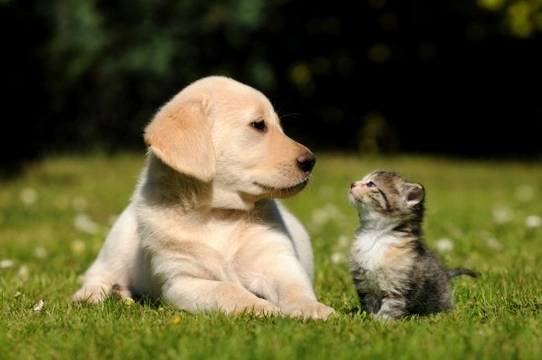
Stopping your cat from bullying your dog!
Received wisdom and popular culture would have us believe that when it comes to aggression between dogs and cats, it all goes one way; the dog is the natural predator, and the cat the obvious victim! However, many of us who own both dogs and cats will know only too well that it is often the cat that has the upper hand in the household, and indeed, in order to keep your cat safe, your dog should have a healthy amount of respect for them!
It is not at all uncommon for some cats to become very dominant where the family dog is concerned, even going so far as to stalk or bully the dog on occasions. In some cats, this behaviour manifests when around other dogs too, and some cats have quite the reputation as the scourge of the neighbourhood dogs! While on the one hand this can be quite funny to observe, particularly if your dog is large and yet still very much under the cat’s thumb; but if your cat attacks your dog, they can do some relatively serious damage. Added to this, if your dog feels unsafe or threatened within their home, this can lead to stress, and a range of associated acting-out behaviours as a result of this.
If your cat is a miniature dictator where your dog is concerned and bullies or chases your dog, there are usually some very precise reasons behind why. Read on to learn about why cats might bully dogs, and what you can do about it.
Managing your cat and dog together
Regardless of why your cat is aggressive or mean to your dog, your first course of action should be to address the day to day realities of life within the household, in order to keep both your cat and your dog safe. Provide areas where only your cat is permitted to go so that they do not have to come into contact with the dog if they choose not to, and close your dog into an area of the home that the cat cannot access when you are out.
Is your cat stressed?
While the main pinch points when it comes to combining cats and dogs within the home generally happen in the weeks immediately after the new addition comes in, stress and unhappiness at living with the dog can affect your cat on many levels, and lead to acting out and bullying.
If something about the setup of your household or the presence of the dog are causing your cat to be stressed, your cat is likely to direct the bulk of its disapproval at the dog itself, for reasons that the dog cannot understand.
The feline prey drive
We tend to think of dogs as having the strongest prey drive, but it is also very inherent within the cat too! This does not always display itself as hunting with aggression, but may mean that your cat views your dog as fair game for a simulated game of stalking and chasing, whether your dog is up for it or not!
Try to ensure that your cat has plenty of outlets for their natural prey drive and has lots of things to play with, and that they see your dog as a friend and not a toy!
Redirection of aggression
If something has got your cat het up, such as a brush with another cat outside or a very energetic game, they may be apt to lash out and not differentiate between the source of their aggression and other things; such as your dog! This form of excitement is ok as long as the cat is only playing and the dog is fine with this, but it can also lead to the dog becoming fearful of the cat.
Possessive tendencies
Cats like to have their own belongings, which smell of them and no one else! If your dog tries to sleep in your cat’s bed, play with their toys or eat their food, this can bring out some strongly possessive instincts in the cat, and lead to them actively defending their things! Ensure that your cat has their own bowls, bed and toys, and if necessary, keep these in an area of the home that the dog cannot access.
Temperamental incompatibility
While stress and getting used to each other in the early days of your pet’s lives together can lead to short term problems, if your cat and dog are incredibly different in terms of their temperaments and activity levels, this type of incompatibility can lead to longer term problems.
This may be the case if you have a young, playful puppy with an older cat, or a cat that wants to play with a dog that just doesn’t know how to react to them. If this is the case, you will need to spend a significant amount of time working with both dog and cat to reach a stage where they will tolerate and ignore each other, rather than fighting.



